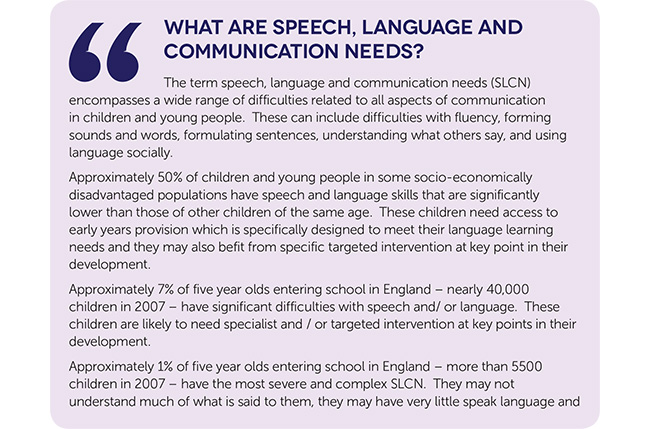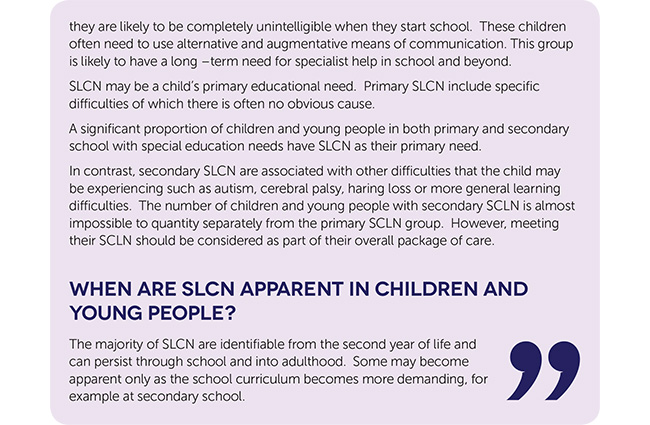Identifying need
The BCRP included several specific studies aimed at understanding the factors that determine need in the population and how these change over time and inter-relate. The BCRP did not specifically investigate the prevalence of SLCN. However, the same research team was asked to synthesis the prevalence data on this issue as part of the Bercow Review. The resulting statistics are widely used as being indicative of SLCN (using the broader definition) in a population of children and young people.
Identifying speech, language and communication need that is associated with disadvantage is an ongoing challenge. Tools are in development which use the association between indicators of disadvantage and population to estimate this type of need19. However there remains no commonly agreed formula.


Change in need over time
Accepting the limitations of the SLCN category as used in the SEN system, a specific study within the BCRP sought to understand the trajectories of need over time through analysis of the national SEN datasets20. This study tracked the category of SEN reported for pupils at School Action Plus and with Statements of SEN with an SEN classification of SLCN and ASD.
Of those children identified at School Action Plus with SLCN at Key Stage 2, the majority (59%) moved to a lower level of need (School Action or no need) by the end of Key Stage 3. Just 18% remained at the same level of need for SLCN. The remaining 17% were re-categorised with another type of SEN, mostly moving from SLCN to moderate learning disability or specific learning difficulty. In contrast, those pupils with statements of SEN where SLCN was the primary need remained consistent over time.

The replacement of the School Action Plus and School Action stages by a single School Support stage as part of the SEND reforms and the move from Statements of SEN to Education, Health and Care Plans, will prevent commissioners directly comparing local data with these findings as part of needs assessment in the future. It should also be borne in mind that the categories of SEN chosen for individual pupils for the school census at the school based stages open to a significant degree of subjectivity.
Another important point to note is that this study was not triangulating any support offered to pupils within their category of School Action Plus, which, by the definition of the time, was a category for pupils who are receiving additional support from specialists additional to the school’s own resources. The evidence of change therefore is quite likely to be in part due to successful intervention for less serious SLCN and not simply natural history of spontaneous improvement.
These data, taken with the summary of prevalence of SLCN (using the broad definition and not the SEN category definition) prepared by researchers for the Bercow Review 22, 23, do allow commissioners to make some tentative assumptions regarding overall prevalence for those whose SLCN at school entry are felt to be largely associated with poor early experience and disadvantage as opposed to a specific long term need.
Further case studies of needs assessment processes based on the prevalence data can be found in the output of the Communication Champion conferences held in 2011 24 and the output from the Communication Council Seminar held in 2014 25.
19. http://www.bettercommunication.org.uk/support-for-commissioners/
20. Meschi, E., Mickelwright, J., Vignoles, A., & Lindsay, G. (2012). The transition between categories of special educational needs of pupils with speech, language and communication needs (SLCN) and autism spectrum disorder (ASD) as they progress through the education system. London: DfE. (Technical report: BCRP 11)
21. Meschi, E., et al (2012) ibid.
22. Bercow, J. (2008) The Bercow Report: A review of services for children and young people (0-19) with speech, language and communication needs. Nottingham: DCSF. https://www.education.gov.uk/publications/eOrderingDownload/Bercow-Report.pdf
23. See Annex 1 for the summary of prevalence data from the Bercow Review
24. Gascoigne, M.T. (Ed), (2012) Better Communication: Shaping speech, language and communication services for children and young people. London: RCSLT
http://www.rcslt.org/speech_and_language_therapy/commissioning/better_communication
